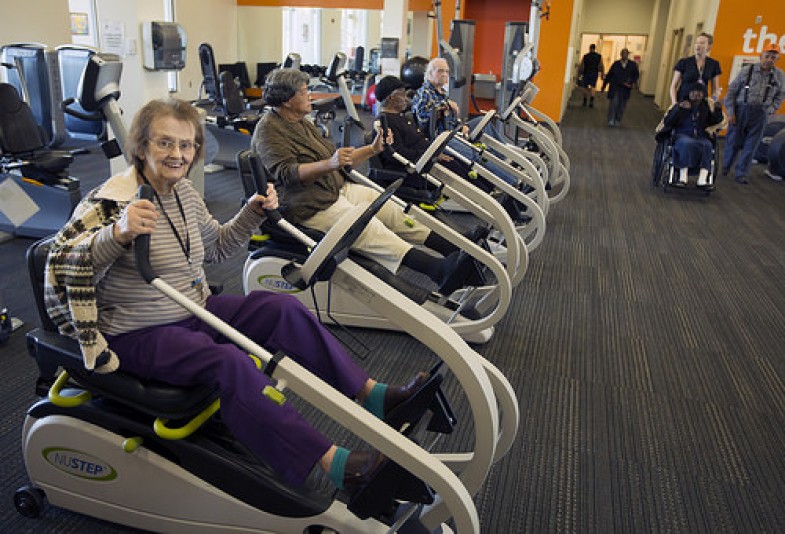One of the greatest challenges in protecting and promoting the commons-- everything belongs to all of us together instead of being privately owned--is the growing sentiment that public institutions such as government are hopelessly inept.
Scandals and snafus ranging from the Secret Service’s lapses to the rocky rollout of ObamaCare are seized as further evidence that any collective effort is doomed from the start. These examples of government’s mishaps are magnified and distorted by right-wing to fuel their crusade against any enterprise that is not beholden to large corporations.
That’s why it’s important to fight back by highlighting public sector success stories such as Heritage Park Senior Services, a state-of-the-art senior community center in Minneapolis that brings services needed by older people together under one roof. The handsome new building on Minneapolis’ lower-income North Side might easily be mistaken for a boutique hotel with its cozy verandah looking out on a park with a pond.
Walking through the front doors, seniors encounter an information desk staffed by friendly faces ready to help direct them to a YMCA specially designed for older users, a rehabilitation therapy center, a health clinic, an adult day services facility, a comfortable lounge with a fireplace and the offices of the Minneapolis Highrise Representatives Council.
Just down the hallway (which is one leg of an 1/8-mile circular indoor walking course) from the Senior Services Center is Feeney Manor, a groundbreaking 48-unit memory care and enhanced assisted living facility. Across the lane is Heritage Commons, a 102-unit assisted living residence.
A clean, cheerful place filled with natural light and stylish furnishings, Heritage Park would make any of us feel less anxious about what life will be like as an older person. Our only concern might be how we could afford to live in such a nice place.
Well, actually, Feeney Manor and Heritage Commons are Minneapolis Public Housing Authority (MPHA) residences for low-income seniors. MPHA also runs the Heritage Park Senior Services Center, which is open to all seniors but especially convenient to those living on the North Side.
“With increasing numbers of older residents in public housing, we realized that many could stay as they aged if they could get daily services,” notes Heritage Park director Evelyn LaRue
“The story of Heritage Park is the creation of a facility that responds to the needs of an overlooked constituency—and the impact on a low-income community,” explains Ron Price, former Senior Program Officer at the Twin Cities Local Initiative Support Corporation (LISC), which helped finance the $16 million project. LISC is a national organization with more than 30 offices around the country that aid residents of distressed communities find solutions to their problems.
“MPHA has done a spectacular job of overseeing the creation process—from designing the facility and getting it built to bringing the right partners to the table,” Price adds. With little expertise in advanced senior care, MPHA contracts with the YMCA for the fitness center, Courage Center for rehabilitation services, Neighborhood HealthSource for the health clinic and Augustana Care Corporation for memory care, adult day services and enhanced assisted living, which is a higher level of care than typical assisted living.
Feeney Manor is the first public housing facility in the country offering memory care and enhanced assisted living, according to Katie Stadther, program manager. Housing officials from across the country have come to visit.
Cora McCorvey, MPHA’s executive director, long recognized the need to offer dignified care for seniors experiencing memory loss, who sometimes become a threat to themselves or other public housing residents. “I would visit a building and find seniors walking in a daze,” she remembers. “They needed some intervention.”
But the housing authority could not remove them without permission from families or the courts—and by the time that happened many residents had often been sent to nursing homes or psychiatric wards.
When Congress passed the American Recovery and Reinvestment Act in 2009, MPHA saw this idea as the kind of shovel-ready project that could help boost the economy at the same time as providing a valuable social service. Stimulus dollars provided nearly 2/3 of the cost with the U.S. Treasury New Markets tax credits and other federal and local programs covering most of the rest. LISC investments helped fill the final gap.
In a time of fiscal constraints, some critics might charge that it’s extravagant for the public to provide this quality of services to low-income people.
“Part of the calculus is that these kinds of services keep people more independent, keeping them out of more costly facilities,” answers LISC Senior Program Officer Erik Takeshita. “Co-locating services like this too also saves money on transportation.” An emphasis on exercise, rehabilitation, adult day services and assisted living care for residents reduces the need for nursing homes, which costs taxpayers two to three times as much as Feeney Manor, according to Stadther.
LaDonna Pierson credits Heritage Park with changing her life. Two years ago, she was diagnosed with Type II diabetes and since has lost 40 pounds by working out at the Y. “I found more than a Y,” shares Pierson, who lives in a nearby public housing building. “I found a family. A lot of us do fun things together here. We have Zumba classes with all the new dance line moves. We have tai chi.”







